

There will likely never be another Capital Football NPLW1 season like the 2020 edition, no thanks to COVID-19. There were postponed season starts as well as a shortened competition, yet the universal feeling in the football community was one of gratitude that a season was possible at all.
As in the Beyond 90 2019 season review, this article gives us a chance to reflect on the season just gone, and to look ahead to season 2021.
Final Ladder Recap

Premiers: Canberra Croatia
Champions: Canberra Croatia (2-0 over Belconnen United in the Grand Final)
Other Semi-finalists: Gungahlin United and Canberra Olympic
Competition observations
There was no Federation Cup competition in 2020, and with only one full round teams could not afford to get off to a slow start if they were to be any hope of figuring in finals football.
It cannot be underestimated just how challenging this would have been for teams and individual players. When the season was first suspended in March it was initially for a period of four weeks, but this was subsequently extended until July, with Round 1 kicking off on July 18th.
In between, clubs had to maintain connection, motivation, and some sort of preparation momentum with their players. The players, meanwhile, had to train in isolation for several months – not an easy ask when you are used to being in a team environment.
The 2020 final ladder reveals:
- a top tier of one team (two in 2019), with undefeated Canberra Croatia ahead of Tier 2 teams by a margin of eight points;
- a second, closely contested tier of four teams (one more in this tier compared to 2019) – Belconnen United, Gungahlin United, Canberra Olympic, and Canberra United Academy. Belconnen United and Canberra Olympic enter this tier in 2020, while Woden-Weston drop out of it. As in 2019, this tier is characterised by teams scoring more goals than conceded; and
- a third tier five points back from Tier 2 consisting of the remaining four teams, with Woden-Weston ahead of the others.
More teams in the second tier compared to 2019 could be one indicator of a closer competition in 2020, and as a spectator that is often how the season felt. It is therefore instructive to repeat the measure of goals scored ratio (top two and bottom two teams) undertaken in the Beyond 90 2019 season review to see if this is indeed the case.
In 2020 the top two teams scored a total 67 goals over 8 games while the bottom two scored 9 goals, yielding a ratio of 7.4 goals per top two team for every goal from a bottom two team. This compares to a ratio of 5.8 goals in 2019, and 6.3 goals in 2018.
So while the competition overall may be perceived as more competitive by virtue of the relative closeness of teams in the middle of the ladder, it would seem that the gap between top teams and bottom teams remains an ongoing issue – under this measure at least.
As far as significant movers up or down the competition ladder in 2020 compared to 2019 are concerned, the one team that stands out is Canberra Olympic. In the last three seasons they have ridden the rollercoaster of semi-finalists in 2018, equal bottom in 2019, and then once again a top four team in 2020.
Finally, it should be noted that the top three teams have the greatest amount of player cycling/rotation in the league (and appear to have been coached with this in mind), granting their players the ability to play in multiple positions and constantly throwing new challenges at opposing defences.
Beyond 90’s Capital Football NPLW Team Of The Year
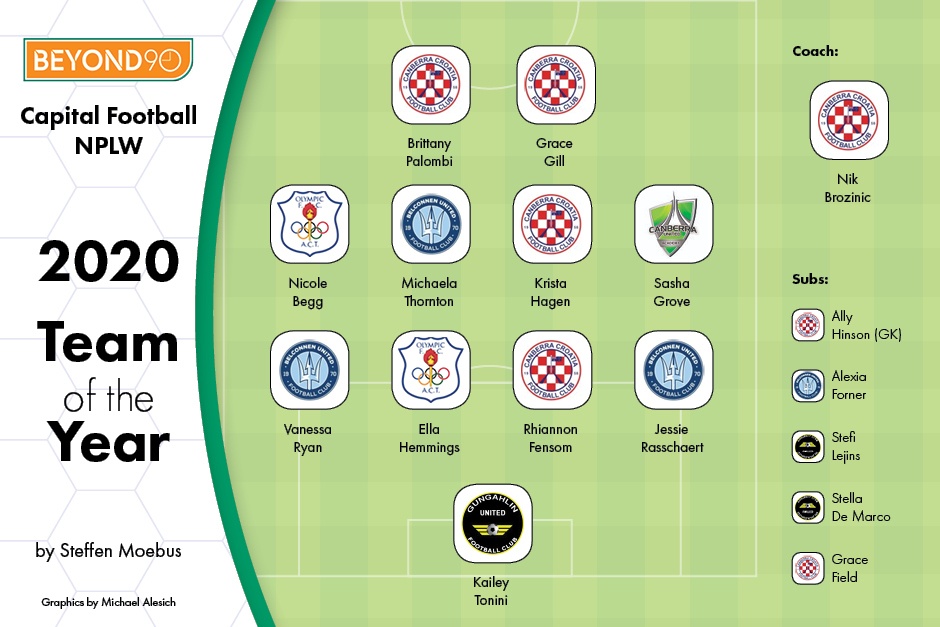

Looking to 2021
The Capital Football board recently endorsed a decision to restructure the format of all National Premier Leagues competitions, with all leagues to have eight teams. The two competitions that are affected by this decision are NPLW and NPL2.
Capital Football CEO Phil Brown remarked that “… In the NPLW, an eight-team format with three rounds increases the number of matches from 16 in the previous structure to 21 matches in 2021, aligning the NPLW competition with the number of matches played in the men’s competitions.”
Clubs will be required to field teams in all age grades (1st Grade, Reserve Grade, U17, U15 and U13).
Beyond 90 understands that all nine existing NPLW clubs were asked to provide a submission to Capital Football by October 19th 2020, outlining their case to remain in the competition. A decision will be made by the Capital Football board in early November. It is currently unknown what the assessment process looks like, or whether club submissions will be accompanied by interviews, for example.
As pointed out in Beyond 90’s recent chat with the Monaro Panthers, the club that is removed from the competition will find it a bitter pill to swallow – especially if the club has a long history in the league – as there is no NPLW2 and no relegation/promotion.
Team by team (in final ladder order)
Canberra Croatia FC – Season 2020 ranking: 1 (Season 2019 ranking: 2)


Coming into the season: Coach Nik Brozinic retained the majority of his squad, but there were some key ins and outs. Ivana Galic and Rachael Goldstein joined Macarthur Rams in the NSW NPLW competition, while Vanessa Ryan made her way across to Belconnen United. Recruits included Rhiannon Fensom, Grace Field, Cecilija Matic, and Ally Hinson.
How the season played out: The record shows that Canberra Croatia were undefeated, going on to win the premiership and championship double … but you wouldn’t have picked that after the way they started in the first two rounds with narrow, unconvincing victories.
The team grew into the season and timed their run to peak form flawlessly. The addition of Grace Field and the emergence of Sharon Chao gave them a four pronged goal-scoring attack, while Rhiannon Fensom had a strong season in the heart of defence alongside Amy McLachlan. That’s without even talking about equal golden boot Brittany Palombi, Julie Murray Medal winner and captain Grace Gill’s efforts this season, or the key role played by ball-winner and creator Krista Hagen.
Canberra Croatia were physically well-prepared and virtually injury free throughout the season. In his second year as coach Brozinic made some outside-the-square (literally) decisions to the benefit of his side, such as the tactic on offensive corners of leaving his two best long range shooters in Grace Gill and Brittany Palombi well outside the penalty box, despite Gill being one of the tallest in the league. This was a game changer in Round 3 against Canberra Olympic, and remained a lucrative tactic all season.
Key player(s): Brittany Palombi, Grace Gill, Krista Hagen, Rhiannon Fensom
Rising star(s): Ally Hinson, Sharon Chao
The addition of ex-Academy keeper Hinson supported CCFC’s strong spine (Hinson-Fensom-Hagen-Gill) and that multi-pronged attack at the apex. Hinson’s assuredness around the sticks all season brought confidence to the players around her.


Chao was a sharpshooter in the early rounds and finished with six goals in 2020.
Belconnen United – Season 2020 ranking: 2 (Season 2019 ranking: 1)
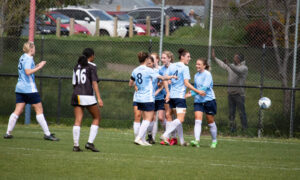

Coming into the season: It was a tumultuous pre-season for Belconnen United, with last-minute coaching changes (Ahmed Ugool stepped into the head coach role at the 11th hour), as well as the losses of Caitlin Munoz (retired), captain Lauren Keir, Bronte Pyke, and Sally James (all to Illawarra Stingrays in the NSW NPLW competition).
Counterbalancing the player losses were the arrivals of Vanessa Ryan (from Canberra Croatia FC) and Mia McGovern (Canberra United Academy). Both were to be important in shaping the team’s fortunes this season.
How the season played out: While the team finished second on the ladder and runners-up in the Grand Final, it was an uncharacteristically topsy-turvy Belconnen United campaign.
On the key measures of goals scored vs conceded, it looked like business as usual. However, two losses (to Canberra Croatia FC and Canberra United Academy) and one draw (against Gungahlin United) show that there were times of unusual vulnerability, even while there were swathes in all three games where the Blue Devils dominated. Losing the services of Alexia Forner to injury in the back half of the season – she had been a strong creative contributor to that point – didn’t help their cause.
McGovern had an interesting season which in some ways reflected the team’s fortunes. After spending the last couple of years as a central midfield general in the Academy setup, McGovern performed well in central defence alongside ever-dependable long throw specialist Karen Clarke in 2020. She also had a short stint on the bench as the defensive formation was tinkered with, and finally started the Grand Final at striker!
Recruit Vanessa Ryan had her strongest season in memory, continuing the club’s fine tradition of overlapping fullbacks contributing to the attack, and was often called upon to mark key opposing attackers.
As summarised by Ugool at the grand final, “… we knew with the players we lost and the coaching changes there was possibly going to be a drop-off; we wanted to ensure that any drop-off wasn’t off a cliff, so for us to finish in second with most goals scored and least goals conceded, and to make the grand final, we have to hold our heads up high.”
Key player(s): Michaela Thornton, Jessie Rasschaert, Vanessa Ryan, Alexia Forner, Karen Clarke
Rising star(s): Maya Osmond, Keira Bobbin
Keira Bobbin was also a Beyond 90 Rising Star for Belconnen United in 2019. Due to illness, her appearances were limited in 2020 to off-the-bench cameos at the back end of the season, but every time she hit the park she reminded us all of her explosive speed and why she continues to be regarded as one to watch.


Maya Osmond embodies the very definition of ‘Rising Star’. Catching the eye with substitute appearances late in the season, Osmond was a selection bolter for the 2020 Grand Final. At just fourteen years of age she already looks comfortable in top-flight NPLW.
Gungahlin United – Season 2020 ranking: 3 (Season 2019 ranking: 4)
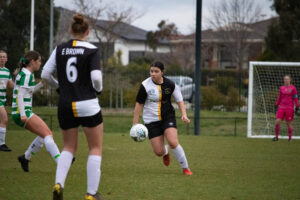

Coming into the season: The only team to retain all players from the end of the 2019 campaign, the Gunners also managed to recruit Ayla Robertson from Belconnen United, Stefi Lejins from Canberra United Academy and Tianah Miro from the 2018 Academy squad.
How the season played out: Just as they did in 2019, GUFC enjoyed a strong start to the 2020 campaign. The new-look midfield trio of Stella De Marco, Lejins, and Miro impressed with their complementary styles, cohesion and creativity. This trio also excels thanks to their ability to cycle with the players around them, a tactic often employed by striker Elke Aitolu.
Having pushed the Blue Devils all the way when they shared the points in Round 4, an injury to central defender Dhiaan Sidhu in the next game marginally changed the balance of the team in the back end of the season. Lejins performed admirably stepping into Sidhu’s role, but a consequence was the loss of Lejins’ engine and understanding with those around her in midfield (thanks to understandings forged in futsal and at the Academy in earlier years).
Gungahlin United were to bow out in the semi-finals, but in finishing third on the ladder have improved their position by one place in successive seasons. They are a young, entertaining side, and already a dangerous proposition for any opponent.
Key player(s): Kailey Tonini, Stella De Marco, Stefi Lejins, Elke Aitolu
Rising star(s): Jade Brown
Two of last year’s Beyond 90 Rising Stars – Stella De Marco and Elke Aitolu – find themselves fairly and squarely on the Key Players list in 2020. Co-captain Kailey Tonini was the beneficiary of GUFC’s first ever dedicated women’s goalkeeper coach, and is listed as Beyond 90’s 2020 goalkeeper of the year.
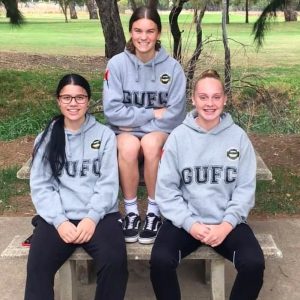

Jade Brown was chosen to represent Australia in the Schoolgirls team just before the pandemic struck, and then had to overcome a delayed start to her NPLW 2020 campaign with the Gunners, but will be another one worth watching in 2021.
Canberra Olympic – Season 2020 ranking: 4 (Season 2019 ranking: 9)


Coming into the season: The Olympic faithful were dreaming of success in 2020. A significant influx of player talent – led by Nicole Begg and Ashleigh Sykes – was backed up by a strong off-season programme of culture-building and mentoring, along with athletic development coaching led by Nicole and Mick Begg.
How the season played out: Nicole Begg is a force of nature, and in her threefold roles as assistant coach, co-athletic development coach and iconic player – together with coach Andrew Woodman and the programmes in place – she was able to instil her willpower into the players around her. Her team-mates could look to no better example and she didn’t let them down, finishing the regular season as equal leading top scorer … from an attacking midfield role.
No better example? Well … perhaps one. Sister (and fellow icon) Ashleigh scored eight goals from just five appearances, and it’s hard not to wonder ‘what if’ she had been able to play the entire season.
Assisted by the new and impressive centre back pairing of Ally Cook and Ella Hemmings, Olympic was a new proposition in 2020. Yet while they would go on to match Belconnen United in the ‘Goals For’ column, they also conceded almost double the number of goals of any other team in the top four.
A pattern became evident whereby it always felt like they could score a goal, no matter the opponent. Their finest performance was likely the 6-2 Round 6 win over Canberra United Academy, which catapulted Olympic into finals reckoning at Academy’s expense.
Olympic racked up large scores against teams in the bottom half of the ladder, but against teams in the top four were guilty of occasional lapses which would result in goals against them, sometimes more than one. Their newfound resilience, however, never let them down, and more than once we were witness to Olympic picking themselves up and threatening those same top four teams late in games, even if they were multiple goals down.
Key player(s): Nicole Begg, Ella Hemmings, Ashleigh Sykes
Rising star(s): Louise Kockum, Emma Croker
Hemmings was one of three recruits from the Monaro Panthers 2018 roster. Her athleticism and decision making are notable, and she deservedly finds herself in the Beyond 90 team of the season.
Kockum impressed late in the season as a replacement attacker for Sykes, scoring twice in the Round 9 game against Tuggeranong United.
View this post on Instagram
Croker (pictured above) was captain Victoria Jamieson’s pick as Rising Star in the Canberra Olympic season preview. While Croker mainly came off the bench, her effort levels were pronounced and she scored two goals to go alongside a six goal haul in Reserve Grade.
Canberra United Academy – Season 2020 ranking: 5 (Season 2019 ranking: 3)
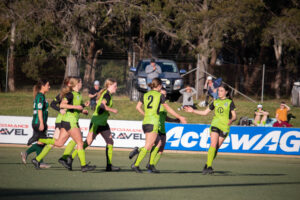

Coming into the season: It is the nature of an age-based academy to have a certain level of turnover. The 2020 season saw the departure of Mia McGovern, Stefi Lejins, Izzy Mulhall, Molly Lawless, Emily Jensen, Demi Nikias, Bianca Kimpton and Jaide Trewin. Incoming players included Sofia Christopherson (Woden-Weston FC) and Anna Hunt (Western NSW Mariners).
How the season played out: With the ledger of ins vs outs a little unbalanced, the Academy relied on the experience of Hayley Taylor-Young (off the back of a W-League season with Canberra United), sisters Annie and Sasha Grove, Young Matilda keeper Izzy Davy, Tara Cannon and Hunt, whose directness and nose for goal led to her sharing Academy golden boot honours in 2020 with Sasha Grove.
As discussed in the Round 2 wrap, the arrival of attackers Hunt and Christopherson to the Academy, coupled with the loss of midfield experience, prompted coach Scott O’Donell to play both Taylor-Young and Sasha Grove in midfield. Taylor-Young’s primary role at the start of the season was as a holding defensive midfielder.
It’s fair to say that it took a while for the team and formation to gel in 2020. Taylor-Young certainly had the pace to sweep in front of the defensive line, however the team missed her potency on the left side of attack. Hunt was proving a success at striker, but an injury to her in Round 3 against Woden-Weston (a game where the team fell away in the second half) brought Taylor-Young back into the attacking fold, where she struggled for a time to re-adjust to her normal attacking game.
It took until Round 8’s big win against Monaro Panthers, with Hunt back in as striker and Taylor-Young regaining her attacking mojo, for the team to put it all together. Their finest hour came in the last game of the season where they toppled reigning champs Belconnen United 2-1.
With straps firmly hit just as the season closed, it would have been interesting to see where the Academy would have finished in any other ‘normal’ year over two or three rounds instead of one.
Sasha Grove was the standout player for the Academy in 2020, endlessly creative, active, sharp, and looking to catch her opponents off guard. It is little wonder that she was selected to join Taylor-Young in the Future Matildas programme, and was also named in the Beyond 90 team of the year. Grove has been with the Academy for five years but we forget that she is just 15 years of age.
Key player(s): Sasha Grove, Annie Grove, Hayley Taylor-Young, Anna Hunt
Rising star(s): Alex Gidis, Izzy Davy


Gidis found success on the right side of attack in 2020, stepping up after Hunt’s injury and scoring three goals, while Davy’s performances in goal continue to place her on the radar of national team coaches scouting her age group.
Woden-Weston – Season 2020 ranking: 6 (Season 2019 ranking: 5)


Coming into the season: Coach Mark Boyd had a relatively stable squad to call upon, with gains including Demi Nikias (CUA) and Lucy D’Arcy (Canberra Croatia). Losses included Sofia Christopherson (CUA) and 2019 captain Cassia Mcglashan (injury).
How the season played out: With the re-emergence of Canberra Olympic and their entry into the top four, Woden-Weston effectively held their ladder position in 2020. To say that they were able to do this without Mcglashan and Christopherson, and with the talented Alex McKenzie only taking part in three games (having chosen to compete in the U18 boys competition for her self-development) is a credit to them. In all three of those games, Woden-Weston looked better with McKenzie on the pitch alongside them.
Sarah Whitfield was the outstanding player of the 2020 campaign. Her smarts allow her to use every second available when in possession and distributing the ball, while her shooting accuracy was on point, netting four on her way to her team’s golden boot award.
As coach Mark Boyd remarked to Beyond 90 in their Round 3 game, when Woden-Weston had their best eleven on the park they were able to match it with most teams in the competition. Results such as their 2-0 win over Gungahlin United in Round 7 proved this … which made results on other days (such as a 0-7 home loss to Belconnen, or a 5-1 loss to Canberra Olympic) head-scratchers, and perhaps a pointer to squad depth issues.
If consistency eluded Woden-Weston in 2019, it wasn’t any easier to find during their 2020 campaign, which started with an unlucky 0-1 home loss to Canberra Croatia where they were right in the game, but ended with a 5-0 away loss to Wagga City.
Key player(s): Sarah Whitfield, Anna Vandenbroucke
Rising star(s): Cristina Esposito
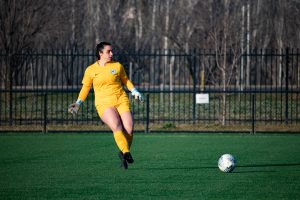

Esposito was a recruit from Tuggeranong United in 2019, showing courage and improvement in her 2020 campaign, and often keeping her team in the game during clutch moments.
Captain Vandenbroucke rose to the captaincy challenge in 2020, inspiring with effort throughout the season.
Wagga City – Season 2020 ranking: 7 (Season 2019 ranking: 7)
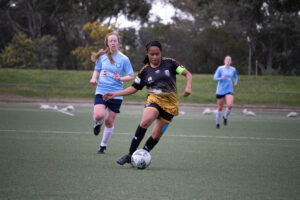

Coming into the season: Coach Sam Gray revealed that while 2020 squad losses included 2019 captain Raechel Hardwicke and Christina Grauer-Kompos, the exciting news was that many of the Under 17s from 2019 who had contributed significantly to their inaugural Capital Football campaign (such as Tess Vaccari, Tia Lyons, and Megan Castle) were promoted to the top grade side. Joining them was Defence Force recruit and former Central Coast Academy player Miranda Walker.
How the season played out: Gray opted to build his youthful team around the defensive leadership of centre back and captain Suze Waia, plus the midfield leadership and strength of Walker (who unfortunately only took part in five of the eight games) and Madeline Harris. In attack, Gray chose to play the exceptionally talented trio of Piper Lockley on the left, Megan Castle in the middle, and Tess Vaccari on the right. Castle took out the golden boot with six goals, while Lockley and Vaccari contributed three each.
Away games were rough on Wagga City in the era of coronavirus. Under Capital Football guidelines, the team had to make the three hour trip on the day of the game and return home straight after. In those conditions and with a young side, fatigue would set in late during Canberra based games.
With so much talent invested in the forward line, there were games – especially against the top four or five teams – where the trio simply didn’t see enough ball. Playing a high defensive line was also a favoured Wagga tactic; swathes of the Round 6 game against Belconnen United, for example, were played in a 20-metre band of the field. This was effective until the second half, when Belconnen perfected the timing of their attacking runs onto well-weighted Alexia Forner diagonal balls.
Results were mixed. A promising 3-4 home loss in their opening game against eventual premiers Canberra Croatia was followed by losses to Olympic and Academy, with their first win coming in Round 5 against Monaro Panthers. They would have been disappointed with their performance in a 2-0 Round 7 loss to Tuggeranong United (which was avenged by a 3-1 win over the same opposition in the post-season playoffs), but ended the regular season on a good note with a 5-0 home win against Woden-Weston.
Yes, the team finished third from bottom, but there are definitely good things to take away from the season. Many of the promoted Under 17 players performed well and took part in every game, such as Ava Tuksar (1 goal), Vaccari, keeper Samantha Emms and Castle. At around the same age, Lisa Cary (2 goals) and Lockley also showed their quality by taking part in each week of the season.
If this group can be kept together and guided by a few senior players in the next few years, as was the strategy in 2020, then the future will be bright for the young Wagga City Wanderers team.
Key player(s): Megan Castle, Suze Waia, Miranda Walker
Rising star(s): Tess Vaccari, Piper Lockley
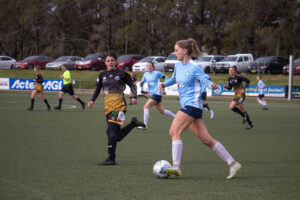



Both Lockley and Vaccari ooze quality, and Beyond 90 cannot wait to see how they progress into 2021. Lockley is also an accomplished midfielder, so it will be interesting to see where on the pitch she ends up playing next season.
Tuggeranong United – Season 2019 ranking: 8 (Season 2019 ranking: 6)
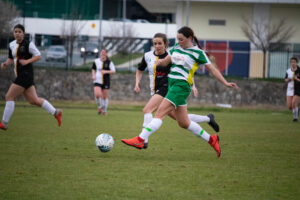

Coming into the season: Tuggeranong’s young squad have largely been together for a couple of years but were thirsty for some additional quality signings. These came in the form of goalkeeper Bella Sanzari (Uni of NSW), Jacquie Freeman (Queensland), plus Alyssa Bozinovska and Sofia Furlanetto from the Monaro Panthers.
How the season played out: The loss of key figure Kristy Helmers after Round 1 (overseas opportunity) was offset by the exciting mid-season news that Canberra United midfielder Emma Stanbury had agreed to a guest stint with Tuggeranong.
Stanbury was to play only four games but in that time provided some leadership and direction to the team as a number 10. Most importantly, she was a link to striker Madeleine Magee, where in previous years we have often seen strikers isolated. It’s a shame that the partnership didn’t last longer, as Magee capitalised on Stanbury’s vision and service late in the season, taking out the golden boot award with three goals.
Tuggeranong’s best performance for the year came in Round 7 with a 2-0 win over Wagga City, and their worst defeat was 6-0 against Canberra Olympic in the final round. Tuggeranong conceded on average one goal less per game in 2020, but with Canberra Olympic bounding up the 2020 ladder and Wagga City winning big in their last game of the season against Woden-Weston, they finished two positions lower compared to 2019.
Coach Michael Aldred gave some insights into his assessment of the season when speaking to Sandy Bay Media (Facebook) in early October. With potentially a larger squad at his disposal in 2021, competition for on-field starting positions will be fiercer, which will help to further raise standards in the playing group.
Key player(s): Steph Coates, Sarah Daisley
Rising star(s): Madeleine Magee
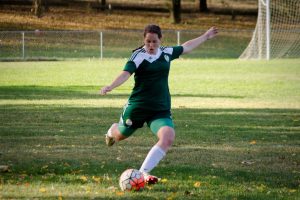

Captain Coates provides steel and discipline at the back, while Daisley is capable of that x-factor every team needs.
Monaro Panthers – Season 2020 ranking: 9 (Season 2019 ranking: 8)


Coming into the season: There was a lot of turnover at the Panthers prior to the 2020 season. Coach Ian Worthington made way for Paul Townsley, and 2019 captain Alicia Meuronen left to try her hand at the NSW NPLW1 competition with Illawarra Stingrays. As one captain and long bomb specialist left, another arrived in the form of Raechel Hardwicke from Wagga City Wanderers.
Hardwicke was joined by Tayla Zanotto from Woden-Weston, but also absent in 2020 were influential American Kaitlyn Joy and Singaporean Chris Yip-Au. On a more local level, both Alyssa Bozinovska and Sophia Furlanetto chose to play for Tuggeranong United in 2020.
As stated in the Monaro Panthers 2020 season preview, one major development behind the scenes prior to the season commencement was an agreement with the Brindabella Blues Football Club to field combined teams in the NPLW competition. This together with the movements outlined above saw a total of 20 new players across the first and reserve grades joining the club.
All in all, the changes amounted to a generally young and somewhat inexperienced Panthers squad taking on the NPLW competition in 2020.
How the season played out: The season statistics show that they started and ended with 9-0 losses, and in between there were two games where the team conceded ten goals on the way to gaining only a single point, in a Round 2 draw with Tuggeranong United.
Dire results indeed, but as pointed out in a recent discussion with Beyond 90, many in the greater squad were new to the grade. The Beyond 90 discussion also reveals that some big picture thinking took part in 2020 around the women’s programme at the club. With new sporting hub infrastructure becoming available nearby, an emphasis on culture and mentoring, plus W-League player Emma Stanbury signing on as 2021 NPLW coach, there are reasons to be optimistic.
Key player(s): Raechel Hardwicke, Thembi Compton
Rising star(s): Liz Edwards, Heather Brayshaw
Hardwicke was the team’s golden boot with three goals, as well as the central holding midfield ‘follow me!’ general.


Compton continued the promise of last season at centre back, working with Hardwicke to form a defensive spine.
While Brayshaw in defence (having spent time in US college football) and Edwards in attack (with one goal this season) played at opposite ends of the field, they are players to watch for the future, never losing their will to compete and making the best of the onfield situations they are faced with.
Follow all our ACT NPLW coverage here.






